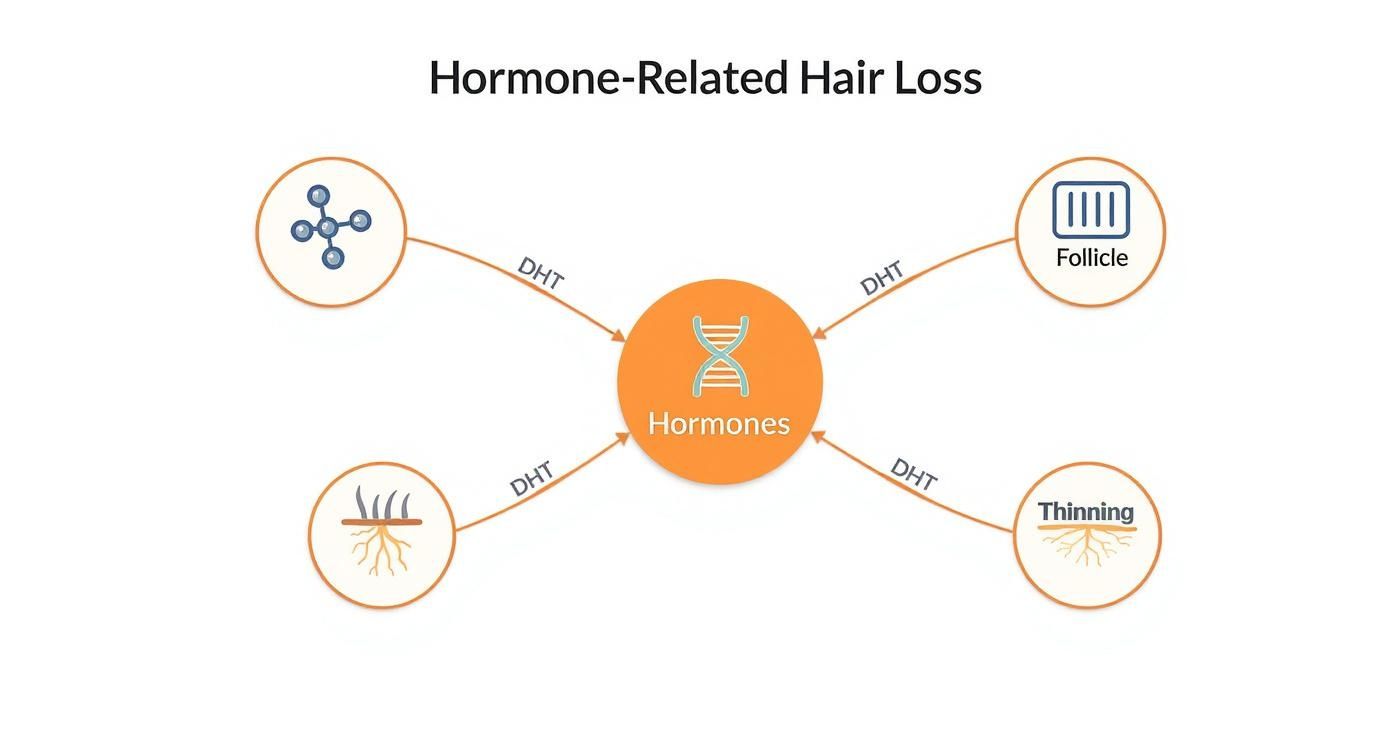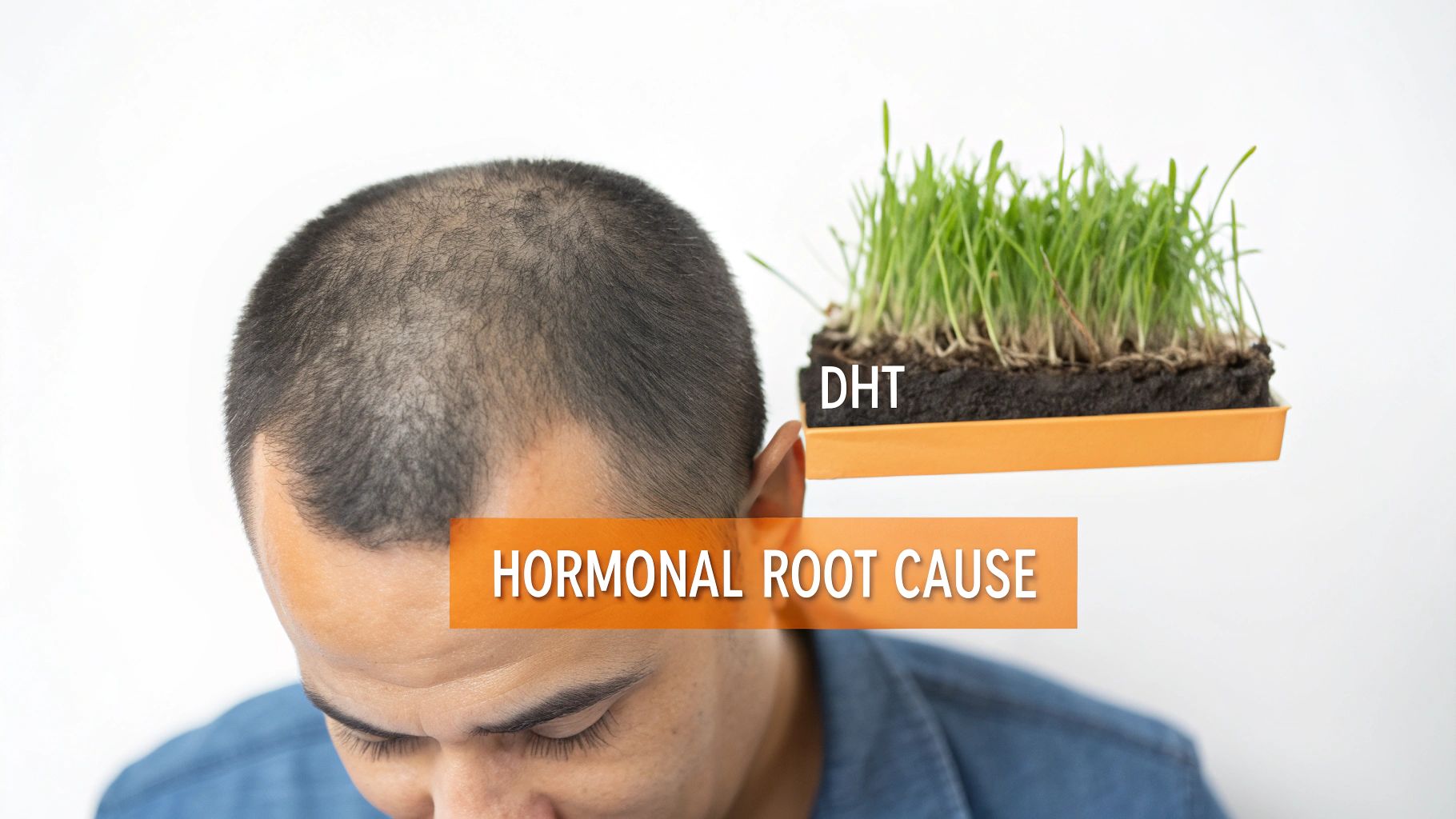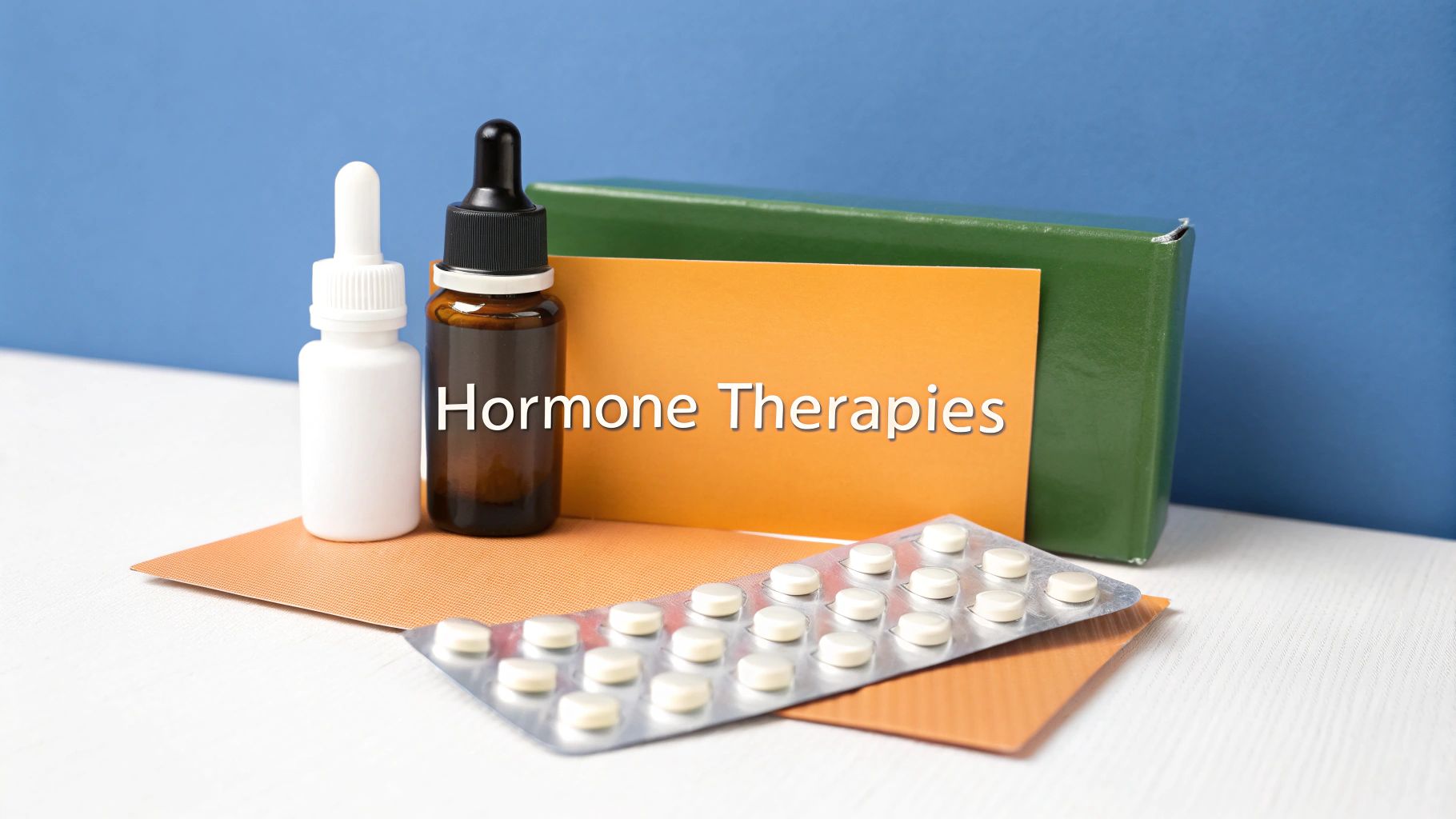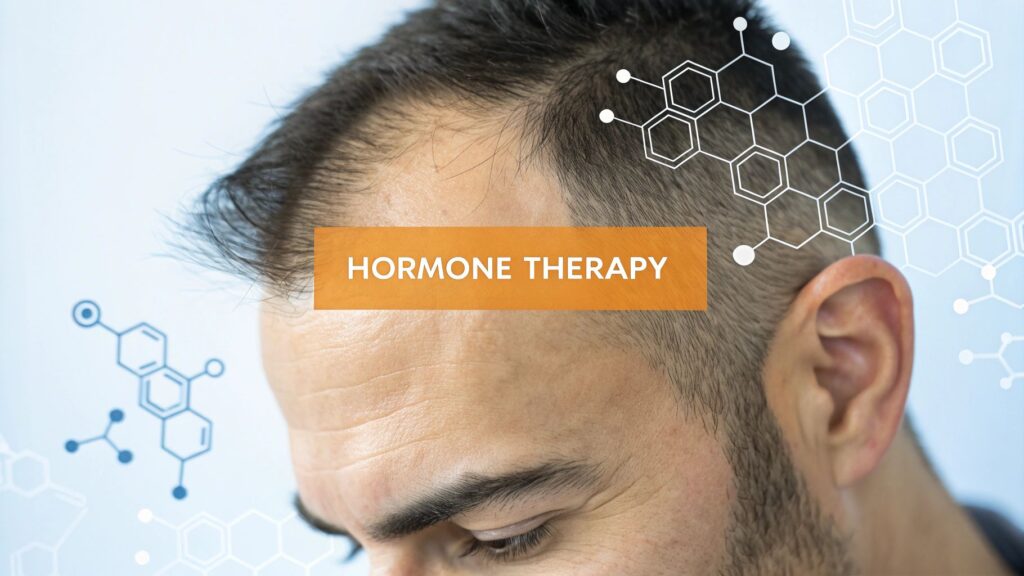Hormone therapy gets right to the source of the problem, correcting the imbalances that cause hair follicles to shrink and, eventually, stop producing hair altogether. It specifically targets the effects of dihydrotestosterone (DHT), a powerful hormone that’s a primary driver of androgenetic alopecia—what we commonly call pattern hair loss—in both men and women. By bringing these key hormones back into balance, the therapy aims to stop further thinning in its tracks and can even kickstart new growth.
Why Hormones Are a Root Cause of Hair Loss
To get why your hair might be thinning, it helps to think of your scalp as a garden. Each hair follicle is a tiny, complex organ responsible for growing a single strand of hair. Just like any garden, it needs the right conditions to flourish, and hormones are the powerful chemical messengers controlling that environment.
When these messengers fall out of sync, the whole system gets thrown off. This is especially true for a group of hormones called androgens, often known as "male" hormones. While everyone has them, a genetic sensitivity or an imbalance is one of the most common reasons for hair loss.
The Role of DHT in Hair Thinning
The main culprit here is an androgen called dihydrotestosterone (DHT). Testosterone, a well-known androgen, gets converted into DHT with the help of an enzyme in your body. While DHT is important for certain developmental stages, it can be a real problem for genetically susceptible hair follicles.
Think of DHT as an aggressive weed in your scalp's garden. It latches onto receptors in your hair follicles and kicks off a process called miniaturization. This process systematically shrinks the follicle, shortening its growth phase and forcing it to produce finer, weaker, and shorter hairs with each cycle. Eventually, the follicle just gives up and stops producing hair entirely.
This infographic helps visualize the chain reaction between hormones, DHT, and the thinning process.

As you can see, this hormonal cascade directly impacts the follicle, leading to the visible thinning that defines pattern hair loss. This is why simply applying topical treatments often isn't enough for many people—they don't address the internal hormonal trigger.
To make these connections clearer, let's break down the key players involved.
| Hormone | Impact on Hair Follicles | Common Association |
|---|---|---|
| Testosterone | Serves as the precursor that converts into the more potent DHT. | The primary "male" androgen, also present in women. |
| DHT | Binds to follicles, causing them to shrink and stop producing healthy hair (miniaturization). | The main driver of androgenetic alopecia. |
| Estrogen | Generally protective; helps extend the hair's growth phase. | The primary "female" hormone; levels drop during menopause. |
| Progesterone | Can help counteract the effects of androgens. | Levels decline during menopause and after childbirth. |
This table shows it's not just about one "bad" hormone but the overall balance. When protective hormones like estrogen and progesterone decline, androgens like DHT can have a much stronger negative effect.
Not Just a Male Problem
Although we often associate it with male pattern baldness, this exact hormonal process is a major cause of female pattern hair loss, too. Women have androgens, and their hair follicles can be just as sensitive to DHT's damaging effects.
Hormonal shifts throughout a woman's life can create periods of vulnerability for hair thinning. These times include:
- Menopause: A major drop in estrogen and progesterone leaves a higher relative concentration of androgens, which can put hair thinning into overdrive.
- Postpartum: The steep decline in estrogen after giving birth can trigger a temporary but often dramatic shedding phase known as telogen effluvium.
- Polycystic Ovary Syndrome (PCOS): This condition often involves higher-than-normal androgen levels, making hair loss a very common symptom.
The scale of this is huge. Hormone-related hair loss affects up to 85% of men and 33% of women at some point. In the United States alone, over 50% of women will experience noticeable hair loss, much of it tied to these hormonal changes. You can explore more hair loss statistics and their hormonal connections in this detailed report.
By understanding that hormones are at the core of the problem, we can see why hormone therapy for hair loss is not just another treatment—it's a direct intervention aimed at the biological root cause. It seeks to restore the hormonal environment your hair follicles need to flourish.
Ultimately, tackling this core mechanism is a powerful strategy for slowing down hair loss and reclaiming fuller, healthier hair. The treatments designed for this purpose are engineered to interrupt DHT's destructive cycle, protecting your follicles and giving them a chance to recover.
Common Types of Hormone Therapy for Hair Loss

Realizing that hormones are at the root of your hair loss is the first big breakthrough. The next is figuring out what to do about it. The world of hormone therapy for hair loss isn't a one-size-fits-all deal; it's a collection of targeted treatments, each designed to interrupt a specific part of the hair loss process.
Think of these therapies as skilled mechanics, each fixing a different part of the engine that’s causing your hair to thin. For men, the mission is usually to neutralize the main aggressor, DHT. For women, the strategy is often more layered, aiming to rebalance the delicate dance between several key hormones.
Let’s break down the most common and effective options out there.
Treatments Primarily for Men
When it comes to male pattern baldness, the game plan is usually pretty direct: stop testosterone from converting into the follicle-wrecking hormone, DHT. This is where a class of medications known as 5-alpha reductase inhibitors comes in.
Imagine the enzyme 5-alpha reductase as the factory that churns out DHT. These medications essentially shut down that factory’s production line. This drastically lowers the amount of DHT circulating in your body and, most importantly, at your scalp.
The most famous medication in this category is Finasteride, often sold under the brand name Propecia. By blocking 5-alpha reductase, it can slash scalp DHT levels by over 60%. That’s often enough to slam the brakes on the miniaturization process and, for many guys, even kickstart some regrowth.
A More Nuanced Approach for Women
Hormonal hair loss in women is a more complex puzzle. It often requires treatments that can adjust the balance between androgens (like DHT) and protective hormones like estrogen.
One of the go-to prescriptions here is Spironolactone. This drug is an anti-androgen, which means it fights hair loss on two fronts:
- It slows down your body’s production of androgens.
- It blocks the androgen receptors on your hair follicles, basically putting up a shield so DHT can't latch on and do its damage.
By protecting the follicles this way, Spironolactone can effectively slow down thinning and create a much healthier environment for hair to grow.
Another common strategy involves certain types of oral contraceptive pills. Combination birth control pills contain both estrogen and progestin, and they can help by:
- Increasing a protein that binds to testosterone, leaving less of it free to be converted into DHT.
- Suppressing the ovaries' production of androgens.
This two-pronged attack helps tip the hormonal scales back in a more hair-friendly direction, making it a valuable tool, especially for women dealing with conditions like PCOS.
Hormone Replacement Therapy for Menopausal Hair Loss
Menopause triggers a massive hormonal shift. As estrogen and progesterone levels plummet, androgens are left with a much stronger influence, which can accelerate hair thinning. This is where Hormone Replacement Therapy (HRT) steps in. The idea is to supplement the body with the estrogen and progesterone it’s no longer making in sufficient amounts.
By restoring levels of these protective hormones, HRT can help counteract the now-unopposed effects of androgens on the hair follicles. This can slow or even stop the accelerated hair thinning many women experience during and after menopause.
It's crucial to know that the type of HRT matters. Some formulas contain progestins that have androgenic properties, which could accidentally make things worse. Working with a doctor who knows their stuff is key to finding the right balance for you.
For those curious about a more natural-feeling approach, you can learn more about how bioidentical hormone therapy helps with hair loss. This method uses hormones that are molecularly identical to the ones your body produces, which many prefer for its tailored application.
Comparing the Different Therapeutic Goals
Every type of hormone therapy has a distinct mission. Understanding what each one is designed to do makes it much easier to see which path might be right for your specific situation.
| Therapy Type | Primary Mechanism of Action | Main Goal |
|---|---|---|
| Finasteride | Blocks the 5-alpha reductase enzyme. | To significantly lower DHT production throughout the body. |
| Spironolactone | Blocks androgen receptors and reduces androgen production. | To shield hair follicles from the effects of existing DHT. |
| Oral Contraceptives | Regulates ovulation and suppresses androgen production. | To create a more favorable hormonal balance overall. |
| HRT (Hormone Replacement) | Supplements declining estrogen and progesterone. | To restore the protective effects of female hormones. |
Ultimately, choosing the right hormone therapy for hair loss boils down to getting a precise diagnosis from a healthcare professional. They can run the necessary tests to pinpoint your specific hormonal imbalance and map out a treatment plan that gets straight to the root cause of your hair thinning.
Your Treatment Timeline: What to Realistically Expect

Starting hormone therapy for hair loss is a commitment. It’s not an overnight fix, and it's important to go in with the right mindset. Think of it like nurturing a garden; you have to consistently care for the soil long before you see the first sprouts. To manage your expectations, you first have to understand the hair growth cycle itself.
Hair growth is a slow, methodical process. A healthy follicle produces only about half an inch of hair per month. When you start treatment, you’re not just waiting for brand-new hairs to pop up. You're waiting for your body to recalibrate its hormonal signals and for your follicles to finish their current cycle before they can start a new, healthier one.
This is a marathon, not a sprint. The changes you’re looking for will happen gradually and in distinct phases.
The First Few Months (1 to 3)
The first phase can be a bit surprising, and honestly, a little alarming for some. It’s actually common to see a temporary increase in shedding during the first few months. While it might feel like the exact opposite of what you want, this is often a fantastic sign that the therapy is working.
This happens because the treatment is pushing out old, weak, dormant hairs to make way for new, stronger ones. It’s essentially a "clearing the slate" phase that primes your follicles for a healthier growth cycle. Seeing more hair in the drain can feel counterintuitive, but it’s a necessary first step.
Key Takeaway: Don't panic about the initial shed. It's a normal and often positive signal that your follicles are responding and resetting your hair's growth cycle—which is exactly the goal.
During these early months, the most important thing you can do is be consistent. Skipping doses can throw off the hormonal stabilization process and set you back. Sticking to your prescribed routine every single day is non-negotiable if you want to see results.
Seeing the First Signs of Progress (4 to 6 Months)
Once the initial shedding phase calms down, the first real positive changes start to show. Around the four-to-six-month mark, most people notice that their daily hair fall has slowed down dramatically. You might find fewer hairs in your brush, on your pillow, or clogging the shower drain.
This is your first major milestone. It’s proof that the hormone therapy for hair loss has successfully stabilized your follicles and put the brakes on the miniaturization process driven by DHT. You might not see dramatic regrowth just yet, but halting the progression of hair loss is a huge win.
Noticeable Regrowth and Beyond (6 to 12+ Months)
From six months onward, the focus finally shifts from slowing loss to actively promoting new growth. This is when the tangible, visible results start to appear. The first new hairs might be fine and short—often called "vellus" hairs—but with continued treatment, they have the chance to mature into the stronger, thicker terminal hairs you’re looking for.
Here’s a realistic breakdown of what to expect:
- Months 6-9: You may start to spot fine, new hairs popping up along your hairline or in areas that were thinning. Your hair might begin to feel just a little bit fuller overall.
- Months 9-12: This is often when the improvements become more obvious, both to you and to others. The new hairs have had enough time to grow longer and thicker, contributing to a visible increase in volume and density.
- After 1 Year: The full effects of the therapy are typically clear after a solid year of consistent use. At this point, you and your doctor can properly assess the success of the treatment and map out a long-term maintenance plan.
Weighing the Benefits Against the Potential Side Effects

Making a smart choice about your health means looking at the whole picture. When it comes to hormone therapy for hair loss, it's all about balancing the very real potential for great results against the possible risks. This isn't about scaring anyone; it's about giving you the knowledge to have a confident, informed conversation with your doctor.
The main benefit is clear and powerful: hormone therapy is one of the most effective medical treatments out there for stopping hair loss and even sparking new growth. Unlike foams and serums that just work on the surface, these therapies get right to the internal root of the problem—the hormonal chaos shrinking your hair follicles. For many, this is the turning point that finally stops thinning hair in its tracks.
The Upside: A Return to Fuller, Healthier Hair
The biggest advantage of hormone therapy is its targeted, no-nonsense approach. By either blocking DHT or rebalancing estrogen and androgen levels, these treatments can effectively shut off the "miniaturize" signal being sent to your follicles.
This does two crucial things. First, it protects the hair you already have. Second, it creates the right conditions for dormant follicles to wake up and get back into the growth phase.
This leads to a few key benefits people notice:
- Less Shedding: One of the very first signs that it's working is seeing far less hair in the shower drain or on your brush.
- Better Density: Over time, as new hairs sprout and existing ones get stronger, your hair can start to feel noticeably thicker.
- Long-Term Control: When used consistently, hormone therapy is a sustainable strategy for managing a chronic condition like androgenetic alopecia for years to come.
Understanding the Potential Side Effects
Of course, any treatment that adjusts your body's chemistry comes with a list of potential side effects. The key is to remember that these are possibilities, not guarantees, and they typically affect only a small number of users. Being aware helps you monitor your health and talk openly with your physician.
For men using DHT blockers like Finasteride, the most talked-about side effects are sexual. A small fraction of users, usually cited as between 1% and 3%, might experience things like a lower sex drive or erectile dysfunction. For the vast majority, these issues never happen. And if they do, they almost always go away after stopping the medication.
For women, the considerations are different. Treatments like Spironolactone or hormone replacement therapy (HRT) can cause their own set of side effects as the body gets used to the new hormonal balance.
These might include:
- Breast tenderness
- Changes in menstrual cycles
- Feeling tired or dizzy
- Mood shifts
It’s important to know that many of these are temporary and can often be managed by tweaking the dose. Your doctor will almost always start you on a low dose to see how you respond before making any adjustments. To get a better handle on the nuances, you can learn more about the complete range of hormone replacement therapy side effects in our detailed guide.
Perspective is Key: While side effects are a valid concern, the data shows they are not the norm for most people. An open dialogue with your healthcare provider is the best way to manage any potential risks and ensure the treatment plan is right for your specific health profile.
The goal is to find an effective therapy that you're comfortable with and that fits your health history. A thorough medical evaluation is the first step, allowing your doctor to screen for any conditions that might make certain therapies a poor choice. Ultimately, this balanced perspective helps you make a decision based on facts, not fear, weighing the life-changing potential of regaining your hair against manageable and often uncommon risks.
Beyond Prescriptions: Modern Hormonal Support
The world of hormone therapy for hair loss is expanding well beyond traditional prescription pills. While oral medications are still a powerful part of the toolkit, a new generation of treatments is coming into focus—offering more targeted, holistic, and personalized ways to restore hormonal balance and kickstart hair growth. This shift is all about getting the right support to the right place, with fewer body-wide effects.
These modern strategies recognize that hormonal hair loss isn’t just about blocking a single hormone everywhere. It's about creating a healthy environment right at the scalp and giving your body the right nutrients from the inside out to correct imbalances. This has paved the way for topical solutions, advanced supplements, and integrated plans that work with your body, not against it.
Topical Anti-Androgens: The Scalp-First Strategy
One of the biggest game-changers is the rise of topical anti-androgens. Think of it like this: instead of spraying weed killer over your entire lawn, you’re applying it directly to the weeds in the garden bed. These treatments are designed to be applied straight to the scalp, where they can block DHT’s damaging effects on hair follicles without getting absorbed into your system in large amounts.
This localized action is the key. By focusing the active ingredients exactly where they’re needed, topical anti-androgens aim to protect the follicle just like traditional hormone therapy, but with a much lower risk of systemic side effects. This makes them a great option for anyone who’s sensitive to oral meds or just prefers a more direct approach.
Nutraceuticals and Supplements: Supporting Hormones from Within
Beyond what you put on your scalp, there’s a growing understanding of how your internal health dictates your hormonal balance. This has sparked the rise of nutraceuticals—supplements backed by clinical research—that are built to support your body’s own hormonal systems and provide the essential building blocks for healthy hair.
These aren't your standard daily multivitamins. We're talking about clinically-backed supplements packed with specific ingredients known to influence hormonal pathways, such as:
- Saw Palmetto: A well-known herbal extract believed to act as a natural DHT blocker.
- Biotin and Keratin: The essential vitamins and proteins that literally form the foundation of the hair shaft.
- Ashwagandha: An adaptogen that can help manage cortisol levels, dialing down the negative impact of stress on your hair growth cycle.
This inside-out strategy works hand-in-hand with other treatments, making sure your body has all the resources it needs to grow strong, healthy hair once the hormonal roadblocks are cleared.
The core idea is simple: a well-nourished body is better equipped to maintain hormonal equilibrium. By plugging nutritional gaps and supporting metabolic health, these supplements help create the perfect internal environment for your hair follicles to thrive.
The Growing Market for Holistic Hair Health
The demand for these gentler, more integrated solutions is skyrocketing. The global market for hair growth supplements and treatments, many targeting hormonal issues, was valued at $7.73 billion in 2023 and is projected to hit $11.58 billion by 2030. This boom is partly driven by social media, where influencers are making younger audiences more aware of hormonal hair loss, expanding the market even further. You can explore more insights on the hair loss treatment market at Grand View Research.
This trend points to a clear future: the next phase of hormone therapy for hair loss is all about integration. It’s about combining the precision of medical science with the foundational principles of wellness, giving you a much broader and more flexible toolkit to restore your hair. This comprehensive approach empowers you to build a multi-faceted defense against hormonal thinning.
How to Know If Hormone Therapy Is Right for You
Deciding whether to start hormone therapy for hair loss is a major step, and it’s definitely not a one-size-fits-all solution. The journey doesn't begin with a Google search or self-diagnosis, but with a real conversation with a medical professional. This is the only way to be sure you're treating the actual cause of your hair loss and not just guessing.
Your first move should be to book a consultation with a board-certified dermatologist. They are the experts in getting to the bottom of hair loss and can run the right tests to see if a hormonal issue, like androgenetic alopecia, is really what's going on.
This process typically involves a close look at your scalp, a deep dive into your medical history, and blood work to get a clear snapshot of your hormonal landscape.
Defining an Ideal Candidate
Once a hormonal link is confirmed, your doctor will look at several factors to see if you're a good fit for this kind of treatment. While everyone's situation is different, the ideal candidates usually have a few things in common.
These often include:
- A Confirmed Diagnosis: Your hair loss is clearly tied to hormonal factors, like your follicles being sensitive to DHT.
- A Specific Pattern: You're seeing the classic signs of androgenetic alopecia—for men, that’s a receding hairline or thinning at the crown, and for women, it’s often diffuse thinning right along their part.
- Good Overall Health: You don’t have any underlying medical conditions that could get tricky when you start adjusting hormones.
- Realistic Expectations: You get that this is a long game. Results show up over many months, not weeks, and it requires a consistent commitment.
Getting good data is a huge part of this. Knowing your baseline hormone levels gives your doctor the information they need to build a targeted plan. For anyone wanting to get a head start, our guide explains how to check hormone levels at home as a great first step before your clinical consultation.
When Hormone Therapy Might Not Be the Best Path
Just as important as knowing who makes a good candidate is understanding who doesn’t. Certain health conditions and life stages can make hormone therapy unsafe or just plain wrong for you.
For instance, this treatment is generally not recommended if you:
- Are pregnant, trying to become pregnant, or are breastfeeding.
- Have a personal or family history of specific hormone-sensitive cancers, like breast or prostate cancer.
- Have a history of blood clots, stroke, or severe liver disease.
In the end, this isn't a decision you make alone. It’s a partnership between you and your doctor. They’ll carefully weigh the potential upside against your personal health profile to map out a path that’s both safe and effective, ensuring your journey to healthier hair is built on a solid foundation of medical expertise.
Frequently Asked Questions
Navigating hormone therapy for hair loss naturally brings up some practical questions. Let's walk through some of the most common concerns people have when they're considering this path.
Is Hair Regrowth from Hormone Therapy Permanent?
The results you get from hormone therapy are not permanent on their own. Think of the treatment as actively managing the hormonal signals that trigger hair loss in the first place. If you stop the therapy, the underlying hormonal process will eventually pick up right where it left off.
This means that over a few months, you'd likely see hair loss return. It's best to view this as a long-term management strategy that you'll need to stick with for as long as you want to maintain your hair. Consistency is the key to lasting success here.
Can I Combine Hormone Therapy with Other Treatments?
Absolutely, and for many people, this is a highly recommended strategy. Combining treatments creates a powerful, multi-pronged attack against hair loss, often delivering better and faster results than relying on a single therapy.
For example, you could use an internal hormone therapy to address the root hormonal cause while also using a topical stimulant like minoxidil, which works directly on the scalp to kickstart new growth.
A combination approach can be incredibly effective because it fights hair loss from both the inside and the outside. Always talk to your doctor to build a safe and effective regimen that’s tailored specifically for you.
How Much Does Hormone Therapy for Hair Loss Cost?
The cost can vary quite a bit, depending on the specific drug, your insurance coverage, and even where you live. Generic medications like finasteride and spironolactone are often quite affordable, typically landing in the $20 to $60 per month range.
On the other hand, branded drugs or more specialized bioidentical therapies can be more expensive. It's always a smart move to check with your insurance provider and your pharmacy beforehand to get a clear picture of what the costs will look like for your treatment plan.
Ready to explore a personalized approach to your health and wellness? The experts at Elite Bioscience offer tailored hormone and peptide therapies to help you reach your goals. Visit our website to learn how we can support your journey to optimized vitality.







